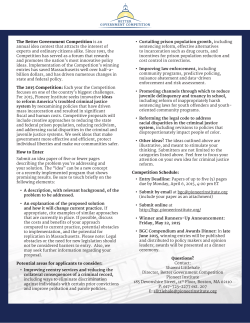
Minimum Standards
Minimum Standards for HIV and AIDS, TB, Hepatitis B and C, and Sexually Transmitted Infections Prevention, Treatment, Care and Support in Prisons in the SADC Region A SAfAIDS Knowledge for Action Summary Paper - March 2015 SAfAIDS Regional Office: 17 Beveridge Road, Avondale, Harare, Zimbabwe. Tel: +263 4 336 193/4, 307 898. Fax: +263 4 336 195. email: reg@safaids.net Country Office - South Africa: 479 Sappers Contour, Lynnwood, Pretoria 0081, South Africa. Tel: +27 12 361 0889. Fax: +27 12 361 0899. email: info@safaids.net Country Office - Swaziland: First Floor, Lamvelase Building, Cnr Sandlane/Nkoseluhlaza Street, Manzini, Swaziland. Tel: +268 505 3140. email: safaidssz@safaids.net Country Office - Zambia: Plot 4 Lukasu Road, Rhodespark, Lusaka. Tel: +260 211 257652, Fax: +260 211 257 609. email: safaids@iconnect.zm Website: www.safaids.net WHAT IS A KNOWLEDGE FOR ACTION SUMMARY PAPER? It is a SAfAIDS advocacy tool to support better communication and social mobilisation on key issues that relate to sexual and reproductive health and rights for all the people of Africa. This paper focuses on the issue of communicable diseases and their treatment, care and management in the prison setting. Why Minimum Standards in Prisons? Prison health is part of community health; most prisoners eventually return to their communities. Those who have acquired communicable diseases in prisons may transmit those diseases to other members of the community on their release. GUIDING PRINCIPLES FOR THE MINIMUM STANDARDS • Political commitment • Confidentiality • Equity • Public health • Greater emphasis on human rights • Compassion/ solidarity. Where can I get the Minimum Standards document? The full document is available on the SADC website (www.sadc.int) and can be accessed via this link: http://www.sadc.int/files/4714/1171/9009/Minimum_Standards_for_HIV_and_AIDSTB_Hepatitis_B_ and_C_and_SexuallyTransmitted_Infections_PreventionTreatment_Care_and_Support_in_ Prisonsin_the_SADC_Region.pdf 2 WHAT ARE THE PARAMETERS OF THESE MINIMUM STANDARDS? AN ENABLING ENVIRONMENT: Detainees’1 needs for shelter, water, food, sanitation, unrestricted access to basic medical care and respect for human rights must be met. AN ACCEPTABLE LEGAL FRAMEWORK: Existing laws should not inhibit interventions for key populations, such as men who have sex with men (MSM), and injecting drug users (IDU). POLICY DEVELOPMENT: Evidence-based policies outlining procedures for infection control, treatment, care and support in prisons should be in place and should facilitate health services equal to the standard provided outside prisons. REDUCTION OF IMPRISONMENT AND PRE-TRIAL DETENTION: Pre-trial detention times should be reduced. Reduction of prison populations, including non-custodial sentencing, should be effected. SOCIAL MOBILISATION AND AWARENESS RAISING: Activities should prioritise health service provision in places of detention. On admission, during prison term and on release, prevention, treatment, care and support services should be provided that match those available outside places of detention and in line with existing Member States’ national guidelines and relevant Regional Minimum Standards. Are these being achieved at national level? What are the barriers to meeting the minimum standards? What needs to be done to support improved parameters on communicable diseases in prisons in southern Africa? 1 Note: The term detainees should be regarded as interchangeable with ‘prisoners’ and ‘inmates’ throughout this document 3 MINIMUM STANDARDS ON ADMISSION Prevention Within 24 hours: üA health and lifestyle questionnaire üScreening for the target diseases2; üPregnancy examination and testing linked to prevention of motherto-child transmission services (PMTCT). üPrevention IEC discussed and shared. Treatment üTreatment should be offered to ALL detainees who are on treatment or who need treatment for communicable and other diseases, to: o Reduce disease-related morbidity o Reduce mortality and disease transmission inside and beyond prisons o Prevent the development of drug-resistant microorganisms due to poor treatment adherence, or inconsistent medication o All detainees with communicable diseases should be treated regardless of their nationality. Care and support üDetainees should be educated and receive IEC on how those infected with the target diseases can best manage their health, and receive materials and services to support their medication üAll detainees should receive good nutrition üPsychosocial support (PSS) should be available as needed üThe establishment of support groups and peer education services is encouraged. 2.‘Target diseases’ in this document refers to HIV and AIDS, TB, Hepatitis B and C, and Sexually Transmitted Infections 4 MINIMUM STANDARDS DURING PRISON TERM Prevention Support the following: üPeriodic education sessions and information packages to support good health practices üPeriodic screening for all communicable diseases üHIV testing and counselling (HTC) üAntiretroviral therapy (ART) for those who need it üNeedle/syringe programmes, and methadone therapy IDUs üPost exposure prophylaxis (PEP) for rape survivors and those who have been exposed to contaminated body fluids üPMTCT services for pregnant HIV-positive female detainees üCondoms üHepatitis B vaccination üIsoniazid preventive therapy to prevent TB in HIV positive detainees and DOTS to treat TB üSTI diagnosis and treatment üVoluntary medical male circumcision üReport and Support mechanisms on stigma and discrimination due to disease status, sexual orientation etc. üRegular sports, study, culture and spiritual activities. Treatment üTreatment should be offered to ALL detainees who, as per admission, are on treatment, along with periodic tests, such as CD 4 cell counts, to guide continued treatment üPeriodic screening to establish new needs for treatment support for ALL detainees. Care and support üPartnerships with custodial and community health services that support health education and information üTerminally ill detainees should be granted early release on medical grounds üPalliative care for all terminally ill detainees who cannot be released üPSS available to all who require it and üThe facilitation of support groups and peer education activities should be considered. 5 MINIMUM STANDARDS PRECEDING RELEASE FROM PRISON Prevention Detainees being released or transferred should be offered: üA comprehensive health assessment and screening for the target diseases üCounselling, which should include IEC packages that are relevant outside prison. Treatment Prison authorities should: üCo-operate and communicate with health service providers outside the prison system – and with other prisons – to ensure continuity of treatment after release or transfer. üEnsure that detainees scheduled for transfer or release have referral letters to facilitate continuation of treatment outside prison. üEnsure that detainees have sufficient medication for 72 hours upon exit or transfer. Care and support Prison authorities should: üEstablish partnerships between custodial and community health services to ensure continuity of care üEnsure that terminally ill detainees are granted early release on medical grounds and receive adequate information and letters of reference to health facilities near their new places of residence üInform ex-prisoners and, where necessary, their families, on how to access their nearest health services üProvide adequate information about support groups near the new places of residence of ex-detainees. 6 PREVENTION, TREATMENT AND CARE FOR GROUPS WITH SPECIAL NEEDS In addition to ALL of the above, some groups require specific health related support. ‘Circumstantial’ children are children of imprisoned mothers (usually below school age) and need: üAccess to paediatric ARVs, if mother is HIV positive and not on treatment üHealth education and IEC for mothers to prevent communicable diseases and support early detection in this group. Children in conflict with the law üAge appropriate materials and services for prevention of disease transmission must be available to juveniles üSufficient psychosocial support must be available to combat substance abuse (especially drug injection), tattooing and other blood-shedding activities. Women üWomen detainees should have access to additional comprehensive maternal and child health services üAdequate supplementary feeding should be available for pregnant and nursing mothers. Physically challenged persons üIEC and BCC materials tailored for hearing and sight impaired detainees should be available. Mentally challenged persons üLinkages should be created between prison health and mental health services to provide appropriate treatment of mental conditions üTailored IEC and BCC materials should be made available. Lesbian, gay, bisexual and transgender persons üServices for preventing and treating communicable diseases in lesbian, gay, bisexual and transgender persons should be tailored to their circumstances and needs. Elderly persons üElderly detainees must be separated from other detainees and must be able to access geriatric health services. 7 TWO MORE IMPORTANT AREAS THAT SUPPORT THE REDUCTION OF COMMUNICABLE DISEASES IN PRISONS PRISON WORKPLACE PROGRAMMES Is there a staff wellness programme, that includes stress management, appropriate workloads and provision of protective clothing? Are prison staff adequately and routinely trained on the target diseases and nutrition appropriate to the prison environment. Do prison staff have access to PEP and HTC? Are there protocols for preventing and dealing with exposure to contaminated blood and/or other bodily fluids? MONITORING, EVALUATION AND RESEARCH Periodic surveys Are confidential, comprehensive, simple medical registers kept of all prisoners for follow-up and disease surveillance? Can external agencies get access to conduct this surveillance? Are prison health staff adequately trained in data gathering? Monitoring and evaluation mechanisms Is the information captured at prison level shared and used in national planning and monitoring? Is the information available at national level reviewed (bi-annually) and shared with the SADC Secretariat? Does the data collected include monitoring case detection, sero-conversion, smear conversion and patient treatment outcomes; ensure complete TB data and data utilisation information; AND produce annual reports on the status of prevention, treatment, care, support and related activities on the target diseases? Is the SADC Secretariat co-ordinating reporting on the target diseases in prisons in the region? Is it facilitating information sharing between Member States on the target diseases? Is it supporting the adoption of standard indicators? 8
© Copyright 2025









